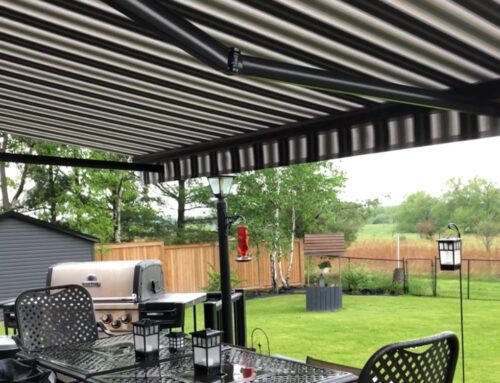Pros and Cons of Different Awning Materials
Awnings offer homeowners both style and beauty while bringing valuable shade to your home. They extend the living space of your home and protect your family from harmful UV rays as much as 94%. They can add charm and personality to your home and transform a plain façade into something special
Awnings have proven to substantially lower air conditioning bills plus protect your furnishings and carpet from fading. In addition to their attractiveness, awnings keep your home much cooler during the heat of the summer months. They help reduce air conditioning costs by decreasing the amount of heat that infiltrates the inside of your home by as much as 77%.

There are different types of materials that are available for awnings. Conventional awnings are often made with wood, metal or cotton canvas, while modern ones are made with materials that are more durable and require less maintenance. However, to make the best choice, knowing the pros and cons of each material is helpful. Here are some of the pros and cons of each type.
Pros and Cons
Canvas: A classic option for awning fabric, canvas is exceptionally strong.
Pros:
- Canvas is a great fabric choice for awnings thanks to its durability and flexibility. It is also a rather inexpensive material that can withstand snow and rain and not get bogged down in the middle.
Cons:
- The material can sag if not stretched properly.
- Canvas awnings may appear a bit rough and out of place.
Cotton: Cotton is another durable fabric. This environmentally-friendly fabric has been the most popular choice for awnings.
Pros:
- Cotton is naturally water-resistant, making it perfect for colder climates.
- It’s resistant to mould and mildew.
- Cotton never loses its shape thanks to its self-contouring properties.
- It’s machine washable.
Cons:
- Cotton is more expensive than canvas.
- It is not flame resistant and is less durable than polyester or canvas.
- Cotton does not hold up as well as synthetic materials. In fact, you will need to seal it with a waterproofing chemical to make it last longer.
Polyester: Polyester is a tough, breathable polymer used in the manufacture of many products. Polyester-based fabrics are translucent by nature, depending on their colours.
Pros:
- As a synthetic, polyester dries quickly and designed to withstand almost any weather condition.
- It’s resistant to wrinkles and retains creases in both wet and dry conditions.
- It’s resistant to high humidity, mildew and harmful UV rays.
Cons:
- Polyester is not a soft material. If touch is important to you, this material is not suitable.
- It’s susceptible to fading based on the amount of sun exposure it gets.
Metal: Most people think of fabric-covered framing when considering awnings, but sometimes only metal will do. Metal is super-strong and comparatively lightweight. It’s ideal for very large applications where awnings need good long-distance visibility.
Pros:
- Aluminum has a low-maintenance surface you can paint in any colour to match your home’s exterior.
- Aluminum awnings tend to be less expensive than other metals.
- Aluminum is environmentally friendly.
- Aluminum awnings are lighter weight and easier to install
Cons:
- Aluminum awnings need to be painted at regular intervals to avoid rust.
- Aluminum awnings are more prone to dents.
- Despite being low maintenance, this fabric alternative requires careful cleaning.
- Aluminum awnings cannot be rolled up.
Fibreglass:
Pros:
- A lighter alternative to aluminum awnings, this material is inexpensive.
Cons:
- Fibreglass requires more maintenance and more frequent replacement compared to other modern awning materials.
Many Choices
As you can see, there are many choices to consider when choosing which awning material works best for you, your home or business. By doing a bit of research upfront and talking to a professional awning company, you will end up with the perfect look you are trying to achieve.





